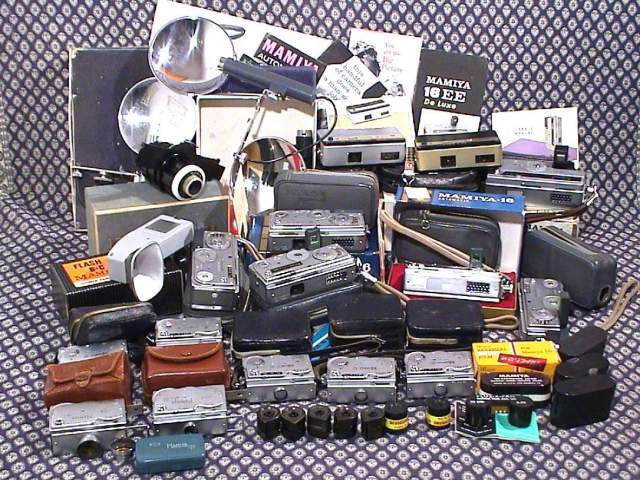introduction | 16 cameras | 16 | 16 Police | 16 Black | Super 16 | Super II | Super III | Tower 16 | Automatic | Revue 16 Automatic | 16 Delux | 16 EE
Mamiya made a range of 16mm subminiature cameras from 1949 until 1962. These cameras are known for their quality, outstanding features and ease of use.

With the introduction of the Mamiya 16 Super, Mamiya switch from the original cassette pairs to a new, single-piece cassette. This was more convenient than the cassette pairs being easier to load. However the design bridged two standard cassettes together and both ends of the film where mounted to take up spools. Later versions dispensed with the spool in the feed side making them more like the Minolta 16 cassette. The Minolta cassette uses a cross ridge inside the take up spool. Mamiya uses a typical slot and spool design as found in many other cameras. Mamiya made a wide variety of cassette styles, but all the types fit in all of their cameras. The original cassettes where metal. Plastic versions with clip on and screw on tops, single and double lobe. Most can be reused but one has glued pieces and usually breaks when separating the parts.
Mamiya promised that film in pre-packaged cassettes would be universally available. This did not happen and many shops would only offer the most popular types (Minolta and Minox and later Rollei). Mamiya lost the battle of the formats, even though their cameras offered a surprising number of features in a tiny package and produced excellent results.
Mamiya made many cosmetic changes within each model, the differences are not well
documented, and the various idiosyncratic types are prized by collectors.
"When I came to look for subminiature cameras in the 1970s
the Mamiya 16 where "moved" out of the way to look for Minolta models. Most
subminiatures where dumped in a single shoe box or the corner of a shelf. The
only cameras I came across were Minox, Minolta, Mamiya and Tessina and a very
few shops had Coronet Midgets (the camera given away with breakfast cereal). Spend the time to look into the way the Mamiya range
developed, they had a true focusing lens very early and a wider aperture than
the Minolta. It is a shame that the numerous 16mm formats lead to their overall
downfall." Gerald McMullon